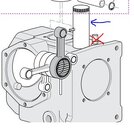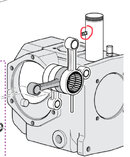Yes the final stage is usually a floating piston and in my case has non metel rings on it ,,,,, more of an O ring type which if scarred will leak into the crank case. Again an air flow gage on the crank case will tell how much is leaking by. I suspect you will find a 80% leak if not more. If you buy another piston get the asssembly in a cylendar. then you just tap it in to place because the rings are already compressed.Are you referring to the 3rd stage rings? The 4th stage piston does not have rings.
When you finish the repair then check the crankcase vent and measure teh air flow. If you have say a 6 cuft compressor and the blow by is .8 then yo uare pumping 5.2 cuft a min. check the blos by at 2k 3k and 4k psi. thta should give you a good perspective on how the compuressor shoudl preform at various back pressures. Mine was 6 cuft at 3k and 5 > 5.5 cuft at about 3800 psi.. of course then check it in dymanic performance by filling a tank from a fully charged filter system. a BPR on the fill whip will make that work for you.





